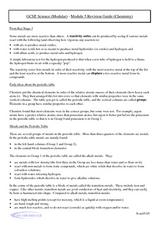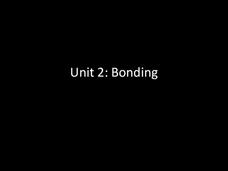Curated OER
Saturn
Looking for a good worksheet to help teach about the planet Saturn? This worksheet is for you! An excellent photograph of Saturn accompanies three paragraphs of text. Pupils answer five multiple choice questions based on what they've...
Chymist
Build a Spectroscope
Assist your emerging scientists with construction of their very own spectroscopes. Individuals construct a spectroscope to identify elements used in varying lights within a particular environment. They conclude the activity with a...
Science 4 Inquiry
Enzymes in Action
Enzymes play a role in almost every function in the human body. Scholars explore three variables related to the use of enzymes. They observe a catalase reaction, experiment with substrates, and examine reactions rates.
Biology Junction
Water Properties and More
Did you know many insects use cohesion or surface tension to walk on water? Using a presentation, scholars learn the more important properties of water. It extends into the concepts of solutions, suspensions, pH, and more.
Curated OER
Student Reading - The Unique Properties of Water
Without water there would be no life on this planet. Biology learners find out why by reading this handout. Create a worksheet of questions to answer after the reading. Follow it up with quick demonstrations or laboratory activities that...
Science Geek
Reaction Types
This is one way to get a reaction from your classes! The lesson presents the different reaction types with an explanation, chemical equation model, and examples. The slides include decomposition, single replacement, double replacement,...
Curated OER
Module 5 Revision Guide - Chemistry
If you use this as an outline for your chemistry lecture on metals, your young chemists will absorb a well-rounded overview. This is not a worksheet per se, but a useful summary of the behavior of metals. Save yourself some planning and...
Curated OER
Bonding
All different types of bonding are covered in this PowerPoint, along with details of resulting bond and molecule shapes. The definitions of traditional molecule shapes and characteristics of behavior are very useful to assist in...
Nuffield Foundation
Microscale Investigations of Catalase Activity in Plant Extracts
Use indirect measurements to monitor metabolic activity in plant cells. Scholars understand that cells with a higher metabolic rate have a higher concentration of catalase enzyme. They use this information to compare metabolic rates of...
Curated OER
Using Percentage in Compound Composition
In this percent composition worksheet, students find the percent of each type of atom in a compound, they find the total mass of a sample and they determine the mass of particular atoms in a compound.
Curated OER
Vocabulary Practice with Present Tense Verbs
Learners determine the meaning of vocabulary in each of eight sentences and select from three possible sentences that have the same meaning expressed differently. A rigorous way to practice vocabulary; more thought is needed than if you...
Science Geek
Properties of Acids and Bases
It's all about that base! Teach the properties of acids and bases using the sixth slide show presentation in a series of seven. The lesson discusses acid and base properties and reactions. Pupils also see the effect on indicators when...
Curated OER
Lead and Mercury Ion Catalase Inhibition
Students participate in a laboratory investigation in which they observe the effect of temperature and pH on enzyme activity. Students also examine exposure to heavy metal ions and the effect that may have on enzyme activity.
K12 Reader
Planets
Readers are asked to identify the main ideas and supporting ideas in a passage about the eight planets in our solar system.
K5 Learning
The Sun and the Stars
How are the stars similar to the sun in our galaxy? Learn all about the solar system with a reading excerpt about the sun and the stars. Kids read an informational passage before they answer questions about reading comprehension,...
LABScI
Acids and Bases: Cabbage Juice pH Indicator
Explore the range of pH using an assortment of household liquids. Scholars create their own pH indicators from cabbage and determine the pH of several liquids. To further their exploration, individuals use the same liquids to create...
Curated OER
Gases and Plasmas
Learners determine what plasma is and why the sun is made up of plasma. They recognize situations where plasmas are found in nature and made by man. They discuss why the sun is a huge ball of plasma and if there are different levels of...
Curated OER
Lots of Leaf
In this science worksheet, students read and analyze information about leaves. Students will consider the 5 questions: How is a leaf like a cook? How is a leaf like a fan? How is a leaf like a pair of lungs? How does a leaf affect the...
Curated OER
Chemical Bonding in Alkanes
In this alkanes worksheet, students complete a table with the chemical formula, the structural formula and the condensed formula of various alkanes given different numbers of carbon atoms. They answer three questions about valence...
Curated OER
WS 7.1 Kinetic-Molecular Theory of Gases/Pressure
In this kinetic molecular theory worksheet, students summarize the points of the kinetic molecular theory, they answer questions about pressure, and draw diagrams to show how suction cups, drinking straws and barometers work.
Curated OER
Covalent and Ionic Bonding:Electron Dot Structures with Ionic Notation
After drawing the valence electron distribution of 13 basic elements, there are spaces to draw 18 more complicated molecules. For each molecule, there is space for a Dot structure and Lewis structure that best describes the...
Curated OER
Review Set
The topics covered in these multiple choice questions are about atomic structure and bonding, state configurations, pressure and solution concentration, and energy graphs. This is a midterm review which could be used with the whole...
Curated OER
Spectral Lines
Slides and slides of emission spectra bring this topic to light for your physics class! Exited electrons returning to lower energy levels is offered as the cause of emission spectra. In summary, viewers learn that we can determine the...
Curated OER
Relative Mass Formula, Atomic Formula, and Empirical Formula
After giving the definitions of the different compound terms and formulas, equations are provided to teach your chemists to calculate different values. Relative formula mass, atomic mass, and empirical mass are shown and explained with...
Other popular searches
- Hydrogen Peroxide Liver Lab
- Hydrogen Atom
- Hydrogen Bonding
- Hydrogen Bonds
- Hydrogen Peroxide
- Hydrogen Ions
- Hydrogen Fuel Cell
- Hydrogen Cycle
- Hydrogen Fuel
- Hydrogen Bonding in Water
- Hydrogen Bonding Lab
- Hydrogen Driven Automobiles























